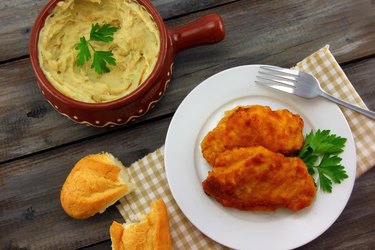
Pan-frying requires a slightly longer cooking time and more turning than deep-frying, but some chicken enthusiasts prefer its ability to produce chicken that is less greasy, and where the meat, rather than the extra-puffy crust, is the star. For pan-fried chicken with a breaded crust, you'll be following the 3 basic steps of breading used in either type of frying -- dredging in flour, dipping in an egg-based wash, then rolling the chicken pieces in breadcrumbs.
Line 'em Up
Video of the Day
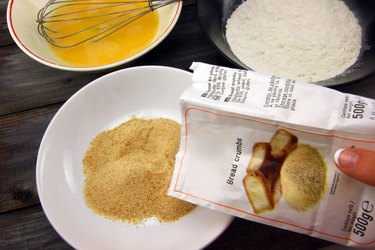
Assembling 3 wide, shallow bowls, such as pie plates, is an ideal setup for efficiently prepping each of your chicken pieces before frying starts. You may want to season your flour with pinches of salt, pepper, paprika, oregano and/or garlic and onion powders. The egg dip can simply comprise 1 or 2 beaten eggs, but some cooks add buttermilk or hot sauce for extra flavor. Finally, the breadcrumb bowl can hold plain breadcrumbs or even crushed cornflakes, but the Japanese style, known as panko, will yield extra crunch after frying. Liven up your breadcrumb mix with a few handfuls of Parmesan cheese or chopped fresh herbs, if you like.
Video of the Day
Dredge, Dip and Roll
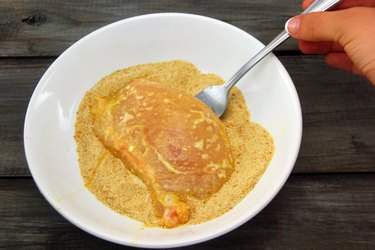
Start by dredging your chicken pieces through the flour. Dredging simply involves running the dry chicken pieces through the bowl, turning or rolling to ensure all sides are coated, then shaking off any excess. Next, dip each piece in the egg mixture, again making sure all sides are coated and that the excess is shaken off. The final step involves rolling or flipping the pieces through the breadcrumbs. Press down hard during this step, so the crumbs adhere well on all sides. If you take an extra 30 minutes after this stage, the rested chicken will have time to literally bond with its crumbly coating.
Skillet Skillz

While the breaded raw chicken is resting on a clean surface, get our your pan. This is not the time to use your lightweight, nonstick pan. Instead, a sturdy skillet with a heavy bottom and deep sides is best. Pour an oil with a high smoke point into the pan, to a depth of about 1/2 inch, and turn the burner to medium-high. Good choices for oil include peanut, canola or grapeseed oils, but you can substitute about half of the oil with clarified butter, if you wish.
Crisping Up
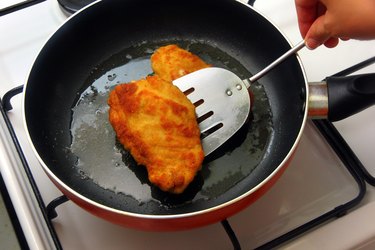
Because you're not deep-frying the chicken, you don't need a special frying thermometer to know when to put the chicken in. The oil should sizzle when you dangle a sample chicken piece onto the surface. Once it does so, add a few pieces to the pan, skin-side down, making sure not to crowd the pan. Whenever possible, fry drumsticks with drumsticks, wings with wings, and so forth. This will help you add and remove the pieces at the same time without having to sacrifice even cooking. Turn the chicken after about 2 minutes, if the side facing the pan looks brown. Keep turning until all sides turn golden-brown and crispy, then remove them to paper towels as you start the next batch.
Check It Out

Before you serve the chicken, it's important to make sure that it is fully cooked. Choose the meatiest cut that you've fried. Piercing the skin with a fork and pressing down is one way to take at least an initial check -- if the juices don't run clear, add that piece back to the pan. Better, yet, use an instant-read thermometer inserted into the meatiest part of the chicken. The temperature should register at least 165 degrees Fahrenheit for safe eating.
Options
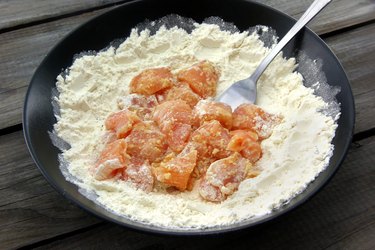
If you're making chicken cutlets or cubed chicken, you might opt for a lighter coating. Instead of making breaded chicken, simply dredge the pieces through flour that you've seasoned to your taste, then leave the pieces to dry for 30 minutes. As with the breaded chicken pieces, the oil you use to pan-fry should come about halfway up the sides of the breast cutlets or cubed pieces. Follow the other guidelines for pan-frying chicken pieces, including checking the internal temperature before serving. Pounded cutlets, being thinner, will cook more quickly than regular bone-in chicken pieces.